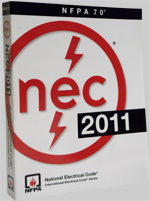|
|
|
|
|
| |
New Safety Requirements
Rapid Shutdown
The 2014/2017 NEC (National Electric Code) requires "PV system circuits installed on or in buildings shall include a rapid shutdown function to reduce shock hazard for emergency responders in accordance with Article 690.12.
In an emergency, the responders will first initiate a rapid shutdown device, then safely move around the roof knowing any areas within 1 foot of a solar array may be energized. As long as they remain more than 1 foot from the solar arrays, any solar AC & DC conductors they encounter will be de-energized.
When CyboInverters are installed on the roof, they should be installed within 1 foot of the solar array. An outdoor UL listed AC switch should be installed next to the electric service panel or a convenient location for the emergency responder to reach. The CyboInverter AC output goes through this AC switch so that it can disconnect the inverter AC output to the grid or to the load. The AC switch can also be used as the rapid shutdown initiator. As soon as the emergency responder turns the AC switch to its Off position, the CyboInverters will shutdown immediately. All AC and AC conductors will be de-energized. CyboInverters do not require a special rapid shutdown device to operate and will comply with the rapid shutdown requirements as long as the installer follow the safety note below.
CyboEnergy's Safety Note for Rapid Shutdown
- This photovoltaic rapid shutdown equipment (PVRSE) does not perform all of the functions of a complete photovoltaic rapid shutdown system (PVRSS). This PVRSE must be installed with other equipment to form a complete PVRSS that meets the requirements of NEC (NFPA 70) section 690.12 for controlled conductors outside the array. Other equipment installed in or on this PV system may adversely affect the operation of the PVRSS. It is the responsibility of the installer to ensure that the completed PV system meets the rapid shutdown functional requirements. This equipment must be installed according to the manufacturer's installation instructions.
- For roof mount PV systems, install the inverter within 1 foot of the PV solar panel array. The Inverter enclosure to panel substrate must have at least 0.5 inch (12.7 mm) open space.
Arc-Fault Protection
The 2011 NEC (National Electric Code) requires Arc-Fault Protection for photovoltaic (PV) solar power systems. This is an important standard to address the fire risks associated with PV solar power systems since arc fault can be a major source of fire.
CyboInverters are designed to have multiple DC input channels, each of which directly connects to a solar panel which has a typical DC output that is less than 58 volts. Therefore, a CyboInverter based PV solar system does not have high-voltage DC and therefore complies with the 2011 NEC Arc-Fault Circuit Protection code.
On the other hand, a central or string inverter based PV solar power system does have high-voltage DC because a series of solar panels are connected together, many of which can have as high as 600 to 800 volts DC. The NEC 2001 Arc-Fault Circuit Protection code (690.11) is an important standard to address this risk factor.
Reference
|
| |
|
|
| |
The following information is from the NFPA70 NEC 2011 book published by National Fire Protection Association, One Batterymarch Park, Quincy, MA 02169. It is a highly recommended reference source for anyone who is interested in this topic.
"690.11 Arc-Fault Circuit Protection (Direct Current).
Photovoltaic systems with dc source circuits, dc output circuits, or both, on or penetrating a building operating at a PV system maximum system voltage of 80 volts or greater, shall be protected by a listed (dc) arc-fault circuit interrupter, PV type, or other system components listed to provide equivalent protection. The PV arc-fault protection means shall comply with the following requirements:
|
 |
|
| |
(1) The system shall detect and interrupt arcing faults resulting from a failure in the intended continuity of a conductor, connection, module, or other system component in the dc PV source and output circuits.
(2) The system shall disable or disconnect one of the following:
a. Inverters or charge controllers connected to the fault circuit when the fault is detected
b. System components within the arcing circuit.
(3) The system shall require that the disabled or disconnected equipment be manually restarted.
(4) The system shall have an annunciator that provides a visual indication that the circuit interrupter has operated. This indication shall not reset automatically." |
|
| |
|
|
| |
|
|
| |
|
|
|

